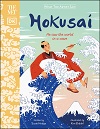|
The Met Hokusai: He Saw the World in a Wave (What the Artist Saw)

Last updated Sunday, August 7, 2022
Author: Susie Hodge
Illustrator: Kim Ekdahl
Date of Publication: 2021
ISBN: 0744039789
Grade Level: 3rd (GLCs: Click here for grade level guidelines.)
Date(s) Used: Aug. 2022
Synopsis:
In What the Artist Saw: Hokusai, meet groundbreaking Japanese artist Hokusai. Step into his life and learn what led him to create more than 30,000 works of art, including his famous woodcut views of The Great Wave off Kanagawa and Mount Fuji. Discover how he planned to live to 110 and even produced the first ever pieces of manga! Have a go at making your own printed artworks.
In this series, follow the artists’ stories and find intriguing facts about their environments and key masterpieces. Then see what you can see and make your own art.
| Note to readers: |
| • |
This book is long, but note that there are questions and activities included throughout the book. Get familiar with the book, so you can focus on the actual story and save the activities for later. Some questions may be helpful as you read.
|
| • |
There are Japanese names and terms that you should know how to pronounce before reading.
|
| Discussion topics for before reading: |
| • |
Find a good example of “The Great Wave” painting online. Explain that they are going to learn about the artist who created this famous artwork. Does it look familiar to them?
|
| • |
Point out Japan on a map or globe. What do they know about Japan? By learning about this painter, we’ll learn a lot about Japan too.
|
| • |
Practice pronouncing the artist’s name and teach the kids how to say it.
Vocabulary:
|
| • |
Having a restless spirit: wanting to keep moving and changing
|
| • |
Depict: to show or represent. Drawings can depict a person or place, for example.
|
| • |
Rival: To be as good. His daughter’s painting rivaled his.
|
| • |
Influence: to have an impact, make an impression or inspire. Hokusai was influenced by earlier artists, and he influenced artists who learned from him.
|
| Discussion topics for during/after reading: |
| • |
Hokusai practiced drawing by copying the work of artists he liked. Is there an artist you like? Do you ever try to draw a picture you’ve seen?
|
| • |
Can you describe what you see on the streets where you live? How are people dressed? What are they doing?
|
| • |
Hokusai wanted to make pictures that were “real,” not perfect. What does that mean?
|
| • |
How large was his biggest painting? How small was his tiniest?
|
| • |
What were some examples of how Hokusai’s art was different from others at the time?
|
| • |
Hokusai changed his name many times. The name he is known by means “North Studio” and refers to the North Star. Do you know the meaning of your name? (Note: It could be fun to have a baby name book handy to look up their names.)
|
| • |
Go through the pictures in the timeline at the end, which shows actual artwork. (No need to read all the titles and explanations.) Just ask kids if they see how his style changed. Each can pick one and explain why they like it (or don’t). Google and share more examples of his art.
|
| Craft ideas: |
| • |
Draw things you see in nature – trees, plants, clouds …
|
| • |
Create some pages for a calendar, showing the seasons (spring, summer, fall, winter).
|
| • |
Hokusai painted more than 100 different pictures of Mount Fuji! How could he make them all different? Try drawing the same object, but show how it would be seen up close or far away, from the front or side, in daytime or night …
|
| • |
There are videos of easy step-by-step directions of how to draw waves. Memorize one yourself and use the whiteboard to lead the kids in drawing their own. Here are a couple you can use. The first one is quite simple, and would be ideal if you have younger kids in the group. The second one is more advanced, for older kids.
https://www.youtube.com/watch?v=A-jhNUI62l4
and
https://www.bing.com/videos/search?q=how+to+draw+waves+easy+step+by+step+for+kids%3a+drawing+tutorial&&view=detail&mid=D1871C5511EEEE789A28D1871C5511EEEE789A28&&FORM=VRDGAR&ru=%2Fvideos%2Fsearch%3Fq%3Dhow%2520to%2520draw%2520waves%2520easy%2520step%2520by%2520step%2520for%2520kids%253A%2520drawing%2520tutorial%26qs%3Dn%26form%3DQBVR%26%3D%2525eManage%2520Your%2520Search%2520History%2525E%26sp%3D-1%26pq%3Dhow%2520to%2520draw%2520waves%2520easy%2520step%2520by%2520step%2520for%2520kids%2520%253A%2520drawing%2520tutorial%26sc%3D0-63%26sk%3D%26cvid%3D9D121E25F045408190FAA74CC9C116F0%26ghsh%3D0%26ghacc%3D0%26ghpl%3D
|
| • |
If there is parental supervision, try making a “woodcut” from a potato, apple or sponge, as shown on p. 24. https://www.persil.com/uk/dirt-is-good/arts-crafts/potato-printing-step-by-step.html . Here is another way of looking at it: https://emmaowl.com/how-to-make-you-own-potato-stamp-the-easy-way/
|
| • |
Can you tell a story with pictures? Draw a few squares with a picture in each one and see if a friend can “read” your story.
|
| • |
Check our craft ideas on Pinterest!
https://www.pinterest.com/pin/381820874669475465//
|
*Note: These craft ideas are just suggestions.
You can use them, but you don't have to use them.
You can expand upon them, or add your own twist.
Remember, though, that the focus of your time should
not be on the development and execution of a craft;
the focus should be on the read-aloud and the
enjoyment of the book!
|
